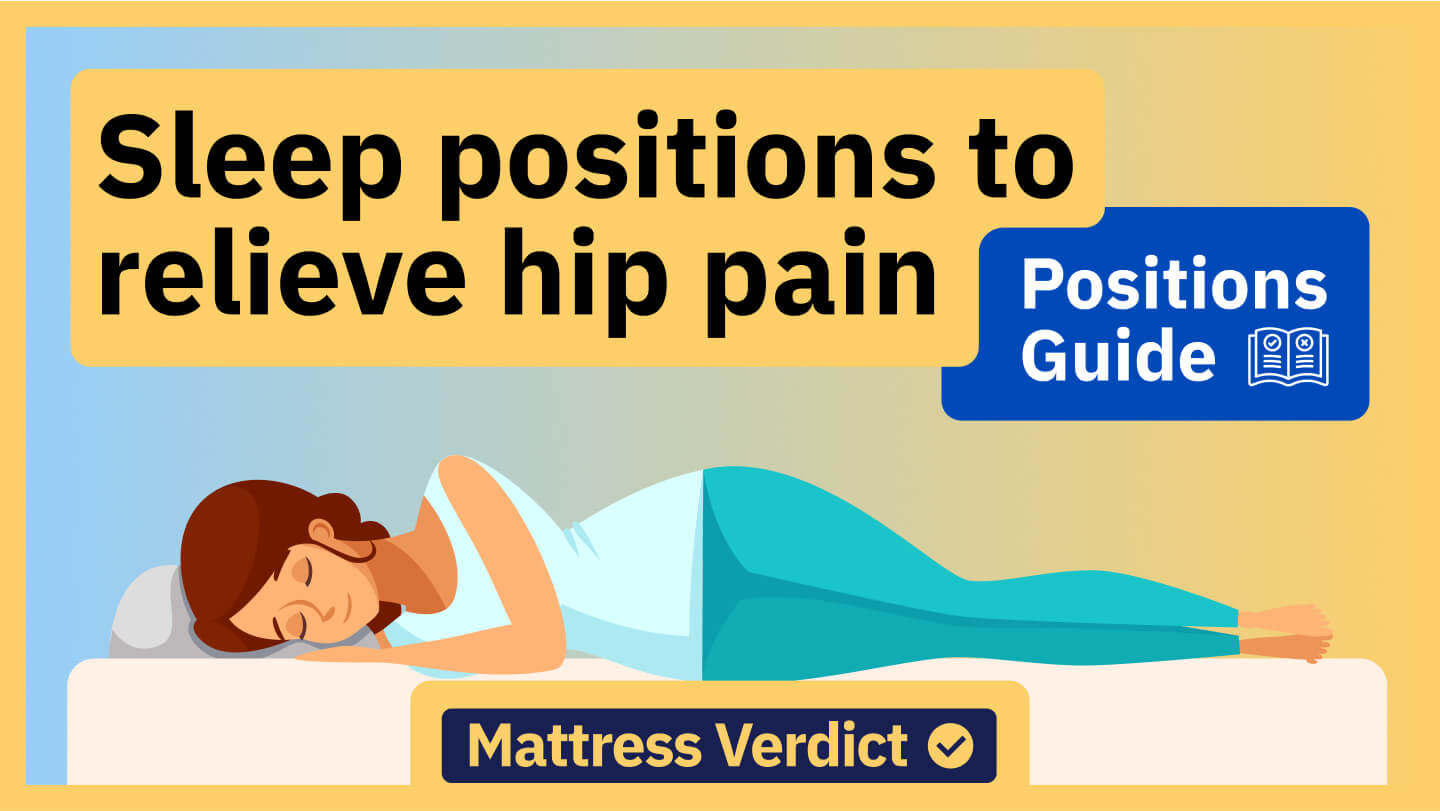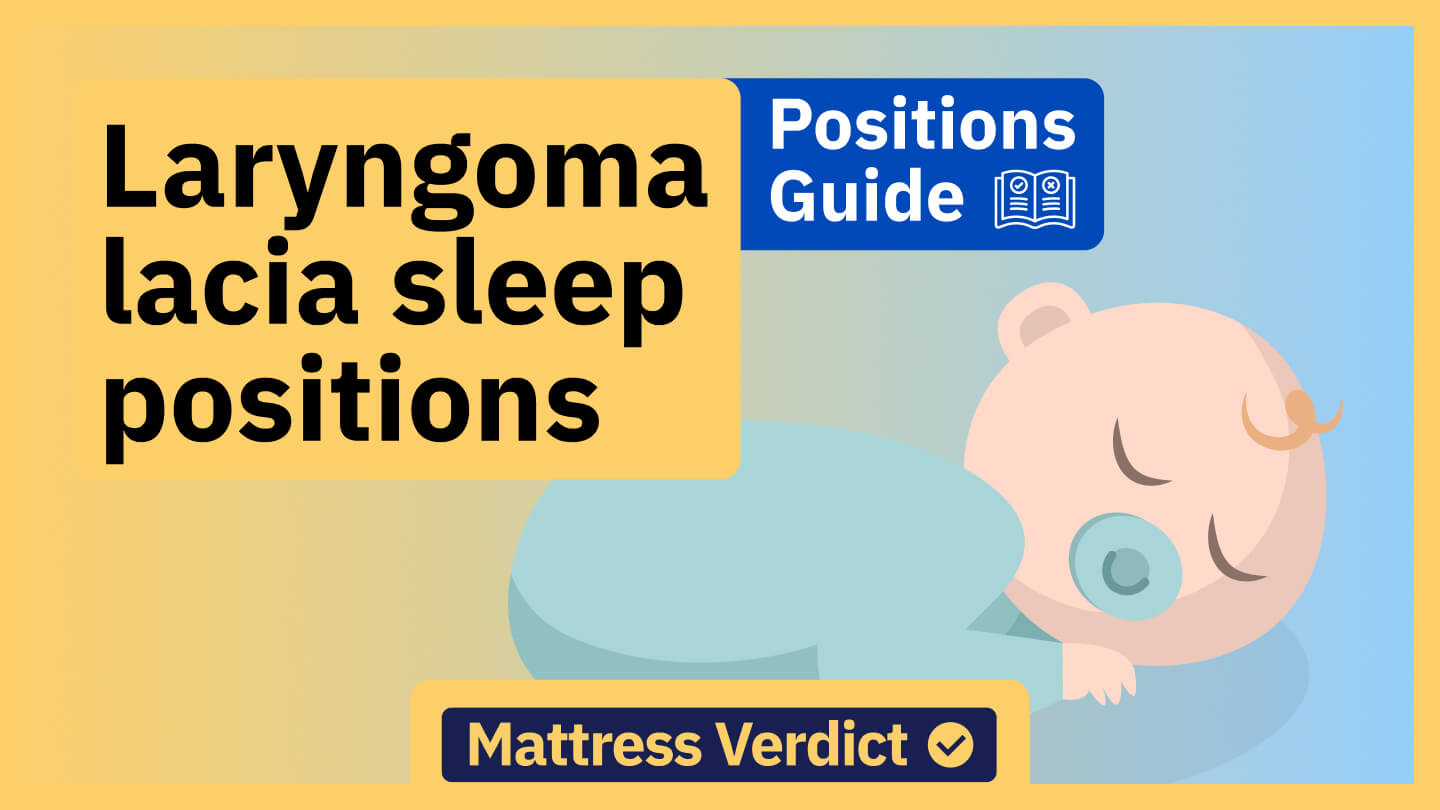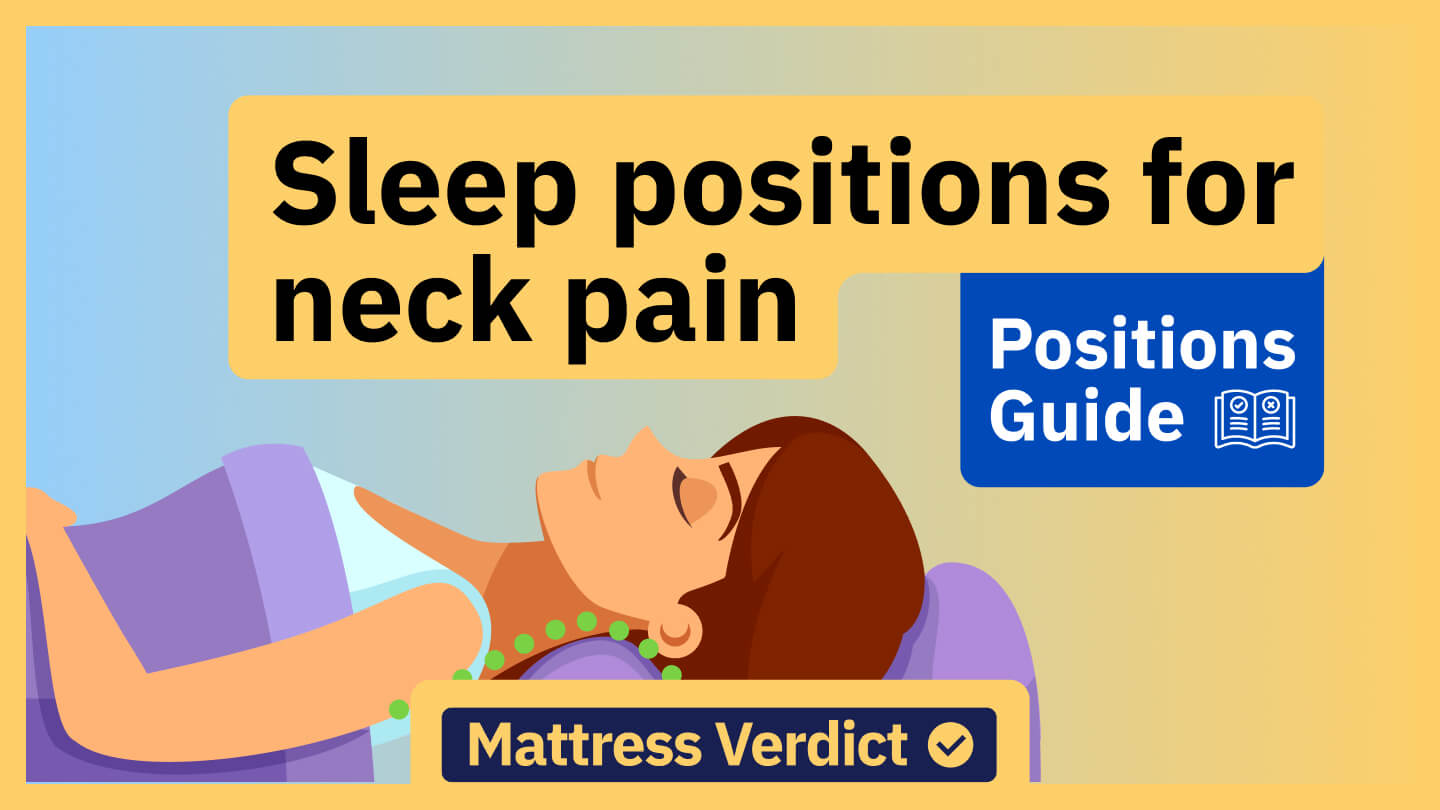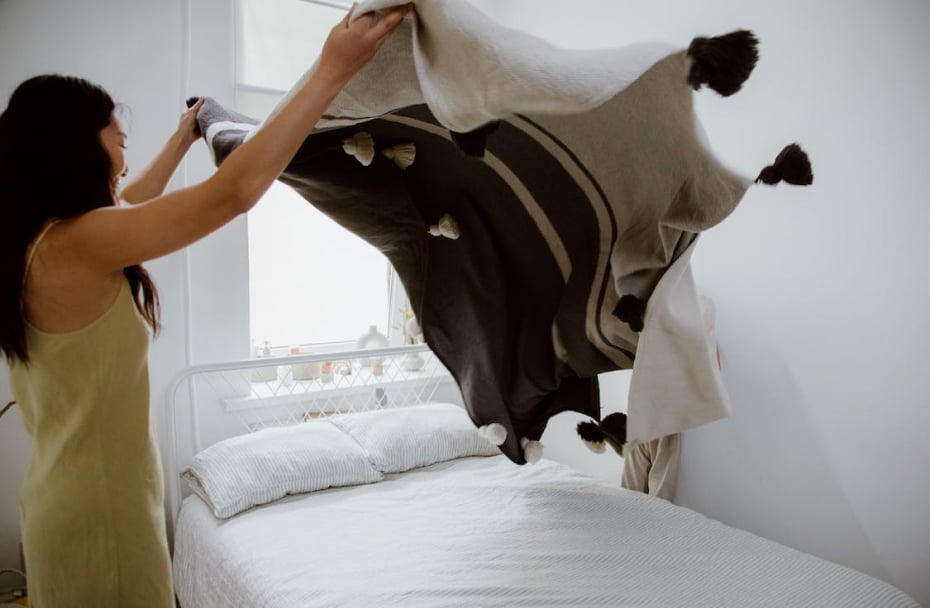

Getting a good night’s sleep is essential to your health and overall well-being. Although you may easily follow the same sleep routine and settle into your favorite sleeping position, your preferred one may not be the best for you. How you lie down can affect other aspects of your health, so finding the best position to sleep is crucial. This guide explains how to find the best sleeping position to get the most out of your night’s rest.
Key Takeaways
- Your sleeping position can affect your sleep quality and overall health
- The best sleeping position is one that allows for a healthy spine alignment
- The best sleeping position for you depends on personal factors like your health condition and body type
What is the Healthiest Sleeping Position?
Have you ever wondered, “What is the healthiest sleeping position for me?” The short answer is, “it depends.” A healthy sleeping position promotes optimal spine alignment from the head to the hips. The best sleep position depends on your health condition and preferences. You may have no trouble sleeping in any position, but as you get older or develop medical conditions, sleep posture may have more impact on your health.
For most people, sleeping on the back or side may be more beneficial than sleeping on your stomach, as these positions support the spine and relax your muscles. If you’re dealing with aches or poor sleep quality, you may need to change your sleep position.
Finding the healthiest sleeping position for you may involve trying a few positions to discover one that leaves you refreshed and pain-free in the mornings.
Different Sleeping Positions – How They Affect Your Overall Health
Fetal Position
The fetal position is the most common sleep position and is beneficial for a lot of reasons. This position improves airflow and is recommended for people who snore, have lower back pain, or are pregnant. It involves sleeping on your side with your knees bent towards your chest and arms crossed in front of your body.
Benefits
-
Promotes healthy spinal alignment
-
Reduces heartburn
-
Beneficial for pregnant women
-
Reduces snoring and sleep apnea
-
Great for older people
Drawbacks
-
May cause soreness or tightness in your shoulders
-
Causes facial wrinkles over time
-
It can lead to discomfort in your arms and legs, especially if your knees are pulled too close to your chest
Sleeping on Your Side
Sleeping on your side is similar to the fetal position, except the knees are not pulled toward the body. Like the fetal position, it helps with snoring and may promote digestion. However, side sleeping may cause jaw tightness on one side.
Benefits
-
Improved airflow and reduced snoring
-
Good sleeping position for pregnant women
-
Helps with back pain
-
Reduces acid reflux
Drawbacks
-
May cause neck, shoulder, or hip pain
-
Can cause wrinkles on one side of the face
-
May be difficult to find a comfortable position for the arms
-
Can put pressure on the stomach, which may be uncomfortable for some people
Sleeping on Your Back
Sleeping on your back involves lying supine with your face up. This position uses gravity to align your back and helps prevent aches and pains by evenly distributing your body weight. Back sleeping may relieve nasal congestion and is a good sleep position to stop coughing, provided you prop yourself with a pillow. Some people, however, can experience their arms going numb when sleeping on their back due to nerve compression.
Benefits
-
Good sleep position for pain in the neck, shoulders, knees, and hips
-
May also be an effective sleep position for sciatica and some nerve-related pain.
-
Prevents nasal congestion
-
Prevent skin wrinkles
Drawbacks
-
Can worsen snoring or sleep apnea
-
May put more pressure on the lower back
-
Can make sleeping difficult for people with acid reflux
Sleeping on Your Stomach
Sleeping on your stomach is not often recommended as it causes neck and back pain and may strain your muscles and joints. However, lying on your stomach may help with sleep apnea and relieve snoring by opening your airways.
Benefits
-
Helps with sleep apnea
-
Reduces snoring
Drawbacks
-
May strain the neck
-
Can cause back pain
Freefall Position
The freefall position is similar to sleeping on your stomach, but your arms are tucked under your pillow or on either side of your head instead of leaving them dangling off your bed. It is a comfortable position and may benefit people who snore or have sleep apnea. However, it may cause some strain on people with shoulder or neck pain.
Benefits
-
Reduces snoring
-
Relieves sleep apnea
-
Offers cozy and comfortable sleep
Drawbacks
-
Can cause neck and shoulder pain
-
Exacerbates acid reflux symptoms
Log Position
The log sleeping position is when you lie on your side with both arms down at your side, your legs straight, and your knees together. It is a great sleep position to relieve hip pain, as it aligns your spine and removes pressure from your joints. However, this position may cause numbness in the arms and legs if they’re held in the same position for long.
Benefits
-
Reduces sleep apnea
-
Relieves neck and back pain
Drawbacks
-
Causes numb or sore arms
-
May cause tight or stiff hips
Soldier Position
In the soldier sleeping position, you lie flat on your back with your arms straight at your sides and your legs straight. This position helps with acid reflux but may cause snoring and sleep disruption.
Benefits
-
Reduces acid reflux
-
Relieves neck and back pain
Drawbacks
-
May cause lower back pain
-
Causes snoring
Starfish Position
The starfish sleeping position involves lying on your back with your arms and legs spread out to the sides. This position allows for optimal spinal alignment and benefits people with back or hip pain.
Benefits
-
Reduces hip or back pain
-
Relieves sleep apnea
Drawbacks
-
Increases snoring
Tips and Tricks on How to Get Used to Better Sleeping Postures
Changing your sleep posture may improve the quality of your sleep and overall well-being. However, changing a sleeping posture you’ve maintained for much or all of your life may take some effort. Moreover, you may change positions multiple times in one night before reverting to your “default” sleeping position.
The technique you need to adopt to change your sleeping position depends on the position you want to switch to. Here are some tips for changing sleeping positions:
Changing to Side Sleeping
Some tricks for learning to sleep on your side include:
The Tennis Ball Method
The tennis ball method entails taping a tennis ball to the back of your pajama top, so every time you turn on your back, the ball pushes against you, making you uncomfortable, so you turn on your side again. The results of this method may take time, and you may need to practice this for an extended period.
Using Special Devices
You can use special devices like sleep belts, sleep backpacks, and wearables to help you remain on your side through the night. These devices offer an electronic version of the tennis ball method; they learn your sleep habits and vibrate whenever you roll into the wrong position.
Pillow Between the Knees
Placing a pillow between your knees while lying on your side in a fetal position can keep your spine aligned and reduce the stress on your hips and lower back. Consider getting a softer mattress if you’re going to switch to side sleeping. Mattress Verdict offers a broad range of top-rated mattresses and reviews to help you select the perfect mattress.
Changing to Back Sleeping
Some tricks for learning to sleep on your back include:
Start Out on Your Back
Lie on your back when you get in bed and try to fall asleep in that position. Consider performing some breathing or meditation exercises to help you relax and drift off in that position.
Use Pillows as Buffers
Using a pillow as a buffer or wedge while lying supine can keep you from turning over to your side when sleeping.
Use an Adjustable Bed
Adjustable beds allow you to lie down in specific positions. They provide an incline that mimics a recliner chair, supports your spine and encourages back sleeping.
Changing to Stomach Sleeping
Some techniques for learning to sleep on your stomach include:
Use Pillows
Place a body pillow or rolled-up towel for support. Also, ensure your mattress is firm enough to support your body without causing discomfort. Try to keep your head in a neutral position by using a small pillow or none at all.
Practice Sleeping on Your Stomach
It can be helpful to practice sleeping on your stomach for short periods during the day to help you get used to it at night.
Factors that Can Determine What Side is Best for You to Sleep on
For most young and healthy people, sleeping on any side may not affect their health or well-being. However, the best side to sleep on for you may depend on factors such as:
Pregnancy
Pregnant women may be able to take any sleeping position in the first trimester. In the second and third trimesters, it may be safer for pregnant women to sleep on their left side as back sleeping exerts more pressure on the blood vessels and can reduce the oxygen and blood flow to the fetus. Some research also suggests that sleeping on your left side may reduce the risk of late-pregnancy stillbirths.
Finding comfortable sleeping positions as a pregnancy progresses can become more challenging. The extra weight can cause aches and pains that make side sleeping uncomfortable. Pregnant women may alleviate their discomfort by placing pillows between their knees and keeping their legs bent. They may also use pregnancy pillows for additional support or try sleeping with their legs elevated to reduce swelling or leg pain.
Health Conditions
Having a health condition may affect the quality of your sleep and your best sleeping position. Some health conditions that can influence sleeping positions include:
Heart Failure
Heart failure occurs due to the heart’s diminished capacity to pump sufficient blood to meet the body’s needs. Some people with heart failure may feel discomfort sleeping on their backs, as the effect of gravity gets more fluid to their lungs, exacerbating their symptoms. Individuals with heart failure may be more comfortable sleeping on their right side or with their heads elevated.
Sleep Apnea
Sleep apnea is a disorder that causes a person to stop breathing while they sleep. It can be caused by several factors, including thyroid problems, obesity, lax muscles, or an underlying neurological condition. Back sleeping may increase the frequency of apnea in some individuals. Side sleeping is the best sleeping position for sleep apnea, as it allows the airways to remain open during sleep.
Snoring
Snoring occurs due to upper airway tissue vibration, leading to noisy or hoarse breathing sounds during sleep. Back sleeping causes the base of the tongue and soft palate to collapse to the back, causing the vibrations that lead to snoring. You can reduce snoring by sleeping on your side or elevating your head by four inches with the help of an anti-snore pillow instead. Most studies suggest that sleeping on your stomach is the top position to minimize snoring issues. However, chronic snoring may be due to sleep apnea or other health issues that may require a medical examination.
Lower Back Pain
Lower back pain is one of the most common issues affecting adults and is often related to one’s sleeping position. Sleeping on your back with a pillow under your knees and your spine in a neutral position helps to distribute your weight evenly across your body. This posture places less strain on your pressure points and alleviates back pain. Sleeping on a mattress with the right firmness and support can also help with lower back pain. Find the perfect mattress for you by checking our best mattresses for back pain guide.
Stomach Problems
People with stomach problems may want to sleep on their left side with their head slightly elevated to prevent the risk of choking on their vomit while sleeping. They may also consider using special side sleeper pillows or even a tennis ball to prevent rolling onto their back.
Acid Reflux
Acid reflux is a gastric disorder that causes heartburn when stomach acid or bile repeatedly flows back into the esophagus – the tube connecting the mouth and stomach. These symptoms are typically more severe when lying down as gravity no longer helps to keep stomach acid down. Side sleeping, especially on the left at an incline, can significantly reduce symptoms of acid reflux. It may also be helpful to elevate the entire upper body by placing a foam wedge under the mattress.
Body Type
Your body type may also determine what sleeping position is best for you. Individuals who are overweight or have a larger frame may find back sleeping uncomfortable as this position exerts pressure on their lungs and stomach. Side sleeping may be best for this group of people as it helps to distribute their body weight evenly. Individuals with smaller frames may find more support and comfort from back sleeping.
Are you plus-sized? Read our best mattress for heavy people guide to find the best mattress for your body type.
Personal Preferences
For many people, the best sleeping position is a matter of personal preference. Some people prefer side sleeping as it feels more comfortable to have their arms and legs close to their body. Others may find the comfort of having their arms and legs spread out while lying on their back more relaxing. Stomach sleepers may prefer their heads tilted to one side. Ultimately, the best sleeping position is one that allows for a healthy and restful night.
Tips on Improving Sleep Quality and Overall Health
Getting a good night’s sleep is essential for your physical, mental, and emotional well-being. However, many people experience trouble getting quality sleep for several reasons. You can improve the quality of your sleep and feel more rested during the day by making simple changes. Here are our top tips for improving your sleep quality.
Reduce Blue Light Exposure at Night
Blue light from your gadgets and electronic devices affects your circadian rhythm, reducing the production of melatonin, the hormone that relaxes and prepares you for sleep. Minimize your exposure to blue light by wearing glasses that protect you from blue light and staying away from your devices two hours before bedtime.
Maintain a Consistent Sleep Schedule
The human circadian rhythm works in a clockwise manner, and having a set sleep-wake schedule can enhance your sleep quality. Try to sleep and wake up at the same time each day, including on weekends, for more restful sleep.
Avoid Coffee in the Evenings
Coffee and other caffeinated beverages stimulate the nervous system and can prevent restful sleep, especially when consumed in large amounts. You may want to avoid drinking coffee in the evenings, especially if you’re sensitive to caffeine.
Cut Down on Alcohol
Alcohol reduces nighttime melatonin production, disrupts sleep patterns, and exacerbates snoring and sleep apnea symptoms. Reducing how much alcohol you consume and avoiding alcohol before bed can significantly improve the quality of your sleep.
Optimize Your Sleep Environment
Your sleep environment can influence how quickly you drift off and your overall sleep quality. Ensure your bedroom is clean, cozy, well arranged, and at ambient temperature. You also want to keep distractions like lights and sound at a minimum for a more satisfying night’s rest. Also, consider replacing your mattress if you have been using the same for a long time. You can take the Mattress Verdict Quiz to determine the best mattress type for you.
Avoid Late Meals
Eating large meals before bed or snacking late at night can affect melatonin production and reduce your sleep quality. If you must eat after dark, consider nutritious foods such as fruit, eggs, whole grain crackers, yogurt, and edamame. Regulating your nighttime eating patterns prevents excessive caloric intake and improves sleep quality.
Increase Daytime Light Exposure
Increasing your exposure to sunlight or bright light during the day allows your body clock to function optimally and prepares you for quality sleep at night.
Avoid Irregular Daytime Naps
Frequent power naps during the day can provide the burst of energy you need to face the day’s activities. However, it can also disrupt your body clock and affect the quality of your sleep. Avoid sleeping during the day, or shorten your naps if you have trouble sleeping at night.
Get Regular Physical Exercise
Regular physical exercise enhances various aspects of your physical and mental health, including your sleep. For people with insomnia, studies show that physical activity offers more benefits than most medications. However, it’s important to avoid exercising close to your bedtime as the stimulatory effects of your workouts can make it difficult for you to drift off quickly.
Consider Using Supplements
Supplements are an easy way to fall asleep faster and get a good night’s sleep. Melatonin supplements are also used to treat insomnia and have no known withdrawal effects. Other supplements for improved sleep include magnesium, lavender, valerian root, glycine, and ginkgo biloba.
See a Doctor
Your inability to get quality sleep may be due to an underlying health condition. It’s essential to seek medical help if you persistently find it difficult to get quality sleep.
Frequently Asked Questions
What is the best direction to face when sleeping?
Scientific research is limited on the best direction to face when sleeping. Your preferences and personal factors like mattress quality, sleep environment, and overall health play a more important role in your sleep quality than the direction you face when sleeping.
What is the best sleeping position for men?
In general, personal factors determine a person’s best sleeping position. However, back sleeping is ideal and healthy for most men as it allows for the neutral alignment of the head, neck, and spine.
Is it good to sleep on the floor?
Sleeping on the floor can make keeping the spine straight during sleep easier, as one does not have to worry about sinking into a soft mattress. While some people feel better after sleeping on the floor, others may experience increased back pain and exposure to colds or allergens.
Where do you put your arms when sleeping on your side?
You may place your arms in front of you when sleeping on your side with your knees pulled up in a fetal position. Another option is to put one arm straight out on your body with the other stretching out in front. Also, you could lie straight on your side with both arms stretched forward. Read more about this in our guide on where to put your arms when sleeping on your side.
How high should your head be raised when sleeping?
Keeping your head raised when sleeping prevents the collapse of your airways, reducing snoring and sleep apnea symptoms. The optimal height for raising your head when sleeping depends on personal factors, but between four and six inches is ideal for most people.




